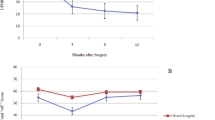Summary
The ventral mesencephalon, containing the developing dopaminergic neurons of the substantia nigra-ventral tegmental region, was obtained from aborted human fetuses of 9–19 weeks of gestation. The tissue was grafted into the striatum of rats previously subjected to a 6-hydroxydopamine lesion of the mesostriatal dopamine pathway. The graft recipients were immunosuppressed by daily injections of Cyclosporin A. Amphetamine-induced motor asymmetry was reduced, and finally totally reversed, only in rats receiving grafts from the 9-week old fetal donor. The fluorescence microscopic analysis revealed large numbers of surviving dopamine neurons, and extensive fiber outgrowth into the host striatum, in these rats. By contrast, rats receiving grafts from 11–19 week old donors had at most only few surviving dopamine neurons. These results indicate that human fetal mesencephalic tissue may be an efficient source of dopamine neurons for functional intracerebral grafting in patients with Parkinson's disease.
Similar content being viewed by others
References
Abercrombie M (1946) Estimation of nuclear population from microtome sections. Anat Rec 94: 239–247
Backlund E-O, Granberg P-O, Hamberger B, Knutsson E, Mårtensson A, Sedvall G, Seiger Å, Olson L (1985) Transplantation of adrenal medullary tissue to the striatum in parkinsonism: first clinical trials. J Neurosurg 62: 169–173
Bazelon M, Fenichel GM, Randall J (1967) Studies on neuromelanin. I. A melanin system in the human adult brainstem. Neurology 17: 512–519
Björklund A, Dunnett SB, Stenevi U, Lewis ME, Iversen SD (1980) Reinnervation of the denervated striatum by substantia nigra transplants: functional consequences as revealed by pharmacological and sensorimotor testing. Brain Res 199: 307–333
Björklund A, Stenevi U, Schmidt RH, Dunnett SB, Gage FH (1983) Intracerebral grafting of neuronal cell suspensions. II. Survival and growth of nigral cell suspensions implanted in different brain sites. Acta Physiol Scand (Suppl) 522: 9–18
Brundin P, Isacson O, Björklund A (1985a) Monitoring of cell viability in suspension of embryonic CNS tissue and its use as a criterion for intracerebral graft survival. Brain Res 331: 251–259
Brundin P, Nilsson OG, Gage FH, Björklund A (1985b) Cyclosporin A increases survival of cross-species intrastriatal grafts of embryonic dopamine-contained neurons. Exp Brain Res 60: 204–208
Brundin P, Isacson O, Gage FH, Prochiantz A, Björklund A (1986) The rotating 6-hydroxydopamine lesioned mouse as a model for assessing functional effects of neuronal grafting. Brain Res 366: 346–349
Brundin P, Björklund A (1987) Survival, growth and function of dopaminergic neurons grafted to the brain. In: Seil FJ, Herbert E, Carlson B (eds) Progress in Brain Research Vol 71, Elsevier, pp. 293–308
Dunnett SB, Björklund A, Gage FH, Stenevi U (1985) Transplantation of mesencephalic dopamine neurons to the striatum of adult rats. In: Björklund A, Stenevi U (eds) Neural grafting in the mammalian CNS. Elsevier, Amsterdam, pp 451–469
Dunnett SB, Bunch ST, Gage FH, Björklund A (1984) Dopaminerich transplants in rats with 6-OHDA lesions of the ventral tegmental area: effects on spontaneous and drug-induced locomotor activity. Behav Brain Res 13: 71–82
Herman J-P, Choulli K, Le Moal M (1985) Hyper-reactivity to amphetamine in rats with dopaminergic grafts. Exp Brain Res 60: 521–526
Jaeger CB (1985) Cytoarchitectonics of substantia nigra grafts: a light and electronmicroscopic study of immunocytochemically identified dopaminergic neurons and fibrous astrocytes. JComp Neurol 231: 121–135
Loren I, Björklund A, Falck B, Lindvall O (1980) The aluminum-formaldehyde (ALFA) method for improved visualization of catecholamines and indoleamines. I. A detailed account of methodology for central nervous tissue, using paraffin, cryostat or vibratome sections. J Neurosci Meth 2: 277–300
Olson L, Backlund E-O, Freed WJ, Herrera-Marschitz M, Hoffer B, Seiger Å, Strömberg I (1985) Transplantation of monoamine-producing cell systems in oculo and intracranially: experiments in search of a treatment for Parkinson's disease. Ann NY Acad Sci 457: 105–126
Olson L, Boréus LO, Seiger Å (1973) Histochemical demonstration and mapping of 5-hydroxytryptamine- and catecholamine-containing neurons systems in the fetal brain. Z Anat Entwickl-Gesch 139: 259–282
Ungerstedt U, Arbuthnott GW (1970) Quantitative recording of rotational behavior in rats after 6-hydroxydopamine lesions of the nigrostriatal dopamine system. Brain Res 24: 486–493
Author information
Authors and Affiliations
Rights and permissions
About this article
Cite this article
Brundin, P., Nilsson, O.G., Strecker, R.E. et al. Behavioural effects of human fetal dopamine neurons grafted in a rat model of Parkinson's disease. Exp Brain Res 65, 235–240 (1986). https://doi.org/10.1007/BF00243848
Received:
Accepted:
Issue Date:
DOI: https://doi.org/10.1007/BF00243848




